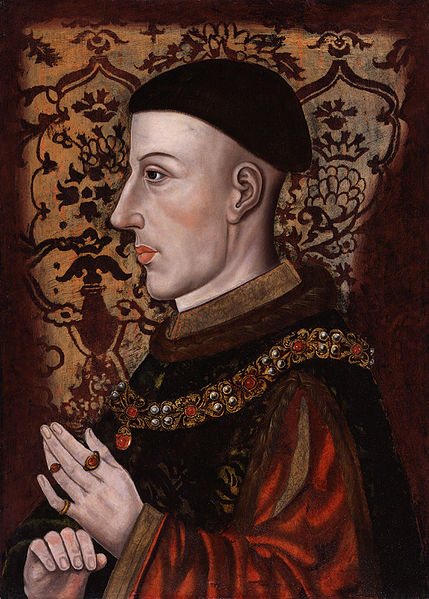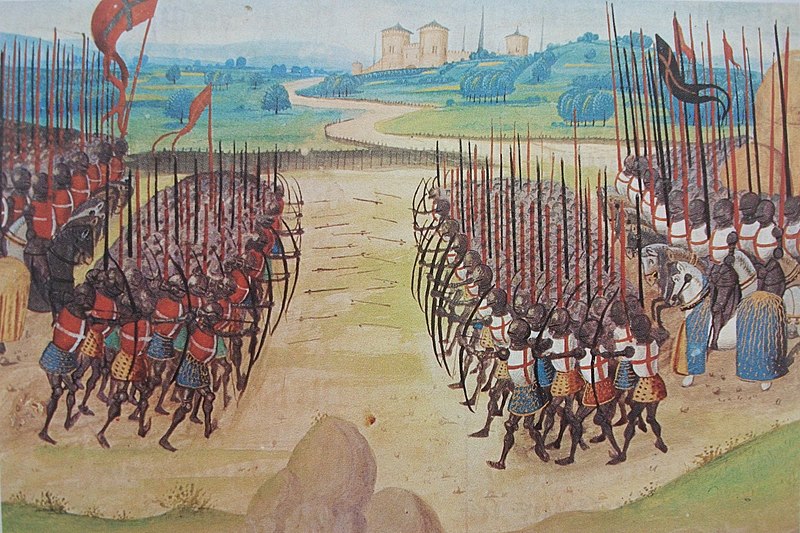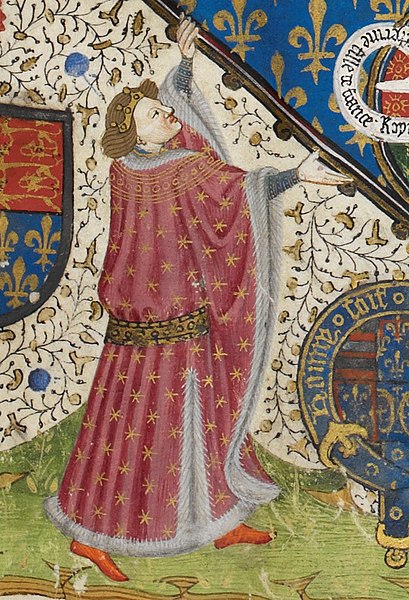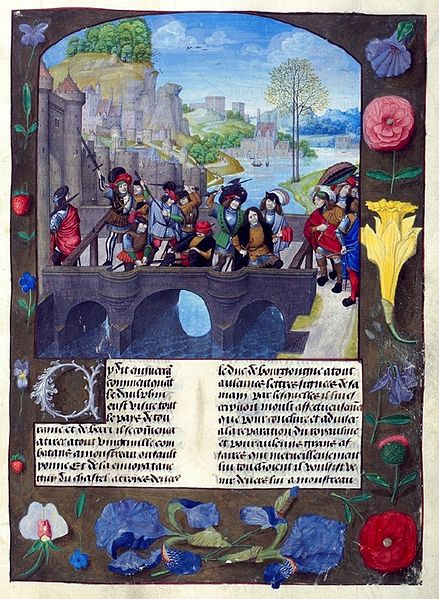 |
| Henry V |
Henry IV’s
bellicose heir had been champing at the bit throughout most of his father’s
reign and when his father died in 1413 Henry V immediately pressed for an invasion of England’s enemy. He
claimed the 1.6 million crowns[i] still owing for the ransom
of John II of France, captured at the Battle of Poitiers in 1356, along with Philip’s grandfather Philip the
Bold. In addition Henry demanded the return of Normandy, Touraine, Brittany, Flanders, Anjou and Aquitaine; demands that were never going to be agreed. Henry also claimed
the hand of the Princess Katherine in marriage along with a dowry of 2
million crowns[ii].
The French
offered Princess Katherine with 600,000 crowns[iii] along with an enlarged
Aquitaine, an offer Henry V deemed insulting. Henry was granted a double
subsidy to allow him to take his quarrel to the French and in April 1415 the
Great Council agreed to go to war. In August the English arrived off Harfleur and promptly besieged the town, which did not surrender until early
October. Henry was left with little choice but to march through Normandy towards
the English stronghold in France, Calais.
 |
| Battle of Agincourt |
John the
Fearless informed Charles VI that he had every intention of fighting for France
and would join the French army at the head of his contingent. On 10th
October the nineteen year-old Philip wrote to the gens de Compte[iv]
at Lille;
‘My father has recently
informed me of his departure with all his power to advance against the English
in the service of the king….and he wishes to have with him everyone in his
lands who is accustomed to bear arms, including we ourselves in person and[ the
Knights and Squires] of Artois.’[v]
Two days
later John wrote again to Charles to confirm the mobilisation of his men and
his imminent arrival. Philip left Oudenaarde, evidently intending to join the royal army at Rouen. The French shadowed the English army as it marched northwards. The two
armies came together at Azincourt.
But neither
Philip nor his father fought on the field at Agincourt; Philip was restrained, probably on
his father’s orders, from leaving Aire[vi], where he was staying at the time.
His uncles Anthony and Philip were not so lucky and died at the battle along
with the cream of the French nobility[vii].
Aftermath
 |
| Duke of Gloucester |
John was not
the only Duke of France to avoid death in battle. The Duke of Brittany failed to proceed beyond Amiens. John must have been pleased at the many deaths of Armagnac supporters
during the battle. The Duke of Alençon and Charles d’Albret, the Constable of France were among the dead and the young
Duc d’Orléans was taken prisoner.
Following
the disaster Henry V wanted John’s support and John and Philip travelled to Calais
to meet with the English king. Henry V hoped to gain John as an ally and
possibly a vassal; John was determined to be no such thing. The two men met in
Calais in October 1416 where John and his son were met by Henry’s brother, the Duke of Gloucester outside Calais;
‘The Duke of Burgundy was
escorted to Calais by the English, while the Duke of Gloucester was accompanied
to St
Omer
by the count of Charolais as hostage for the security for the person of the
said Duke of Burgundy.’[viii]
The subject
of the talks, attended by King Sigismund of Germany[ix] was kept secret. A draft of proposed
treaty had John agreeing to give homage to Henry V at an unspecified future
date when Henry was king of France. John did NOT sign the draft.
The
following month John entered into an alliance with Duke William of Bavaria and
the Dauphin John; John planned to install the Dauphin in Paris under his guidance.
This plan fell apart with the death of the Dauphin on 4th April 1417
and the death of Duke William in May.
The deaths of Anthony of Brabant and
William of Bavaria[x], resulted in turmoil in Brabant. The Brabantian problem was temporarily settled by Philip
under the Treaty of Woudrichem on 2nd February 1419. The treaty,
which favoured John of Bavaria, was not acceptable to Philip’s
cousin and John’s niece Jacqueline Countess of Holland and Zeeland who fell out with her husband John IV of Brabant.
Taking Control
 |
| Troyes |
In April
John charged the Armagnac faction with all manner of imaginary crimes including
the murders of the Dauphins Louis and John and permitting Henry V to invade
France. The charges revivified the Burgundian-Armagnac civil war.
By October
1417 John’s army was virtually besieging Paris even as the English were taking
control of Normandy. Towns across France found themselves at odds as some
declared for John or were divided internally between Burgundian and Armagnac
supporters. John’s armies took a number of towns even as the new Dauphin Charles emerged as the leader of the
anti-Burgundian forces.
J
ohn’s men
rescued the queen from her Armagnac protectors
and the two set up an alternative government at Troyes and in January 1418 Isabeau empowered John with the same powers that she
herself had to rule on Charles VI’s behalf. Immediately Burgundians were
appointed to key roles throughout government.
 |
| Bourges |
John’s men
tightened their grip round the perimeter of Paris, finally taking it 28-9th
May.
‘On this occasion the troops
met with no resistance, and there were only two or three persons killed in the
streets of Paris. These, it was said, had tried to rally support for the Count
of Armagnac.’[xi]
John followed
this coup with a reign of terror in the capital and he had the Count of
Armagnac, and as many of his men could be rounded up, put to death. The Dauphin
set up his power base in Bourges.
In August
1418, not long after regaining control of Charles VI in Paris, John arranged
the transfer of the towns and castellanies of Péronne, Roye and Montdidier[xii] to Philip. The transfer was made on
the grounds that Michelle’s dowry remained unpaid. The grant was significant in
that it extended Burgundy’s borders to the Somme.
Death of the Duke of Burgundy
Meanwhile,
as the French were distracted by bitter infighting, the English were besieging
Rouen; it fell after five and a half months on 19th January 1418.
Spring found both John and the Dauphin negotiating with the English. Between
May and June John had a series of meetings with Henry V at Meulan. They broke off without any agreement being made. John was
also negotiating with the Dauphin and in July the two men met three times,
resulting in the Treaty of Pouilly-le-Fort in which they agreed to govern
France jointly.
On 31st
July the English captured Pontoise and John took the king and queen to Champagne, breaking off negotiations
with the English. John summoned his armies and restarted negotiations with the
Dauphin. He agreed to a meeting with the Dauphin at the bridge at Montereau-Faut-Yonne on 10th September 1419.
J
ohn the
Fearless was murdered by Tanneguy de Chastel[xiii] and Arnaud de Barbazon in the presence of the Dauphin. An
enclosure was set up in the middle of the bridge, where the two men, surrounded
by their advisers, met. John knelt to the Dauphin and put his hand on his sword
when rising, possibly to aid levering himself off his knees.
 |
| Murder of John the Fearless |
One of the
Dauphin’s companions asked; John was immediately attacked with an axe by de
Chastel who did not wait for the duke’s reply. The Dauphin’s men rushed through
the door from their side of the bridge and joined in hacking John to death.
The Dauphin
and his advisers must have feared that John would take complete control of France,
including the Dauphin himself as well as his parents, and consolidate his hold
on power, possibly even overthrowing the king and making himself monarch of the
country. Several of Charles’ advisers had worked for Louis d’Orléans and saw
this as gaining vengeance for their former master’s death. The murder resulted
in a catastrophe for France when John’s son and heir Philip threw his lot in
with the English.
Bibliography
The Hundred
Years War – Alfred Burne, Folio Society 2005
The Reign of
Henry VI – RA Griffiths, Sutton Publishing Ltd 1998
Europe:
Hierarchy and Revolt 1320-1450 – George Holmes, Fontana 1984
The
Fifteenth Century – EF Jacob, Oxford University Press 1997
A Distant
Mirror – Barbara Tuchman, Papermac 1989
John the
Fearless – Richard Vaughan, Longmans, Green and Co Ltd, 1966
Philip the
Good – Richard Vaughan, Boydell Press 2014
www.wikipedia.en
[i]
In 2015 the relative: historic standard of
living value of that income or
wealth is £1,034,000,000.00 labour earnings of
that income or wealth is £12,570,000,000.00 economic status value of that income or wealth is £39,970,000,000.00 economic power value of that income or wealth is £555,000,000,000.00 www.measuringworth.com
[ii]
In 2015 the relative: historic standard of
living value of that income or
wealth is £1,445,000,000.00 labour earnings of
that income or wealth is £12,430,000,000.00 economic status value of that income or wealth is £43,880,000,000.00 economic power value of that income or wealth is £767,300,000,000.00 www.measuringworth.com
[iii]
In 2015 the relative: historic standard of
living value of that income or
wealth is £433,600,000.00 labour earnings of
that income or wealth is £3,729,000,000.00 economic status value of that income or wealth is £13,160,000,000.00 economic power value of that income or wealth is £230,200,000,000.00 www.measuringworth.com
[iv]
Accounts staff
[v]
John the Fearless - Vaughan
[vii]
Charles of Orléans was taken prisoner
[viii]
John the Fearless - Vaughan
[ix]
Future Holy Roman Emperor
[x]
Leaving his daughter Jacqueline to inherit his lands
[xi]
John the Fearless - Vaughan
most of them should have spent more time sitting on the naughty stair with sore bottoms when they were young.
ReplyDelete